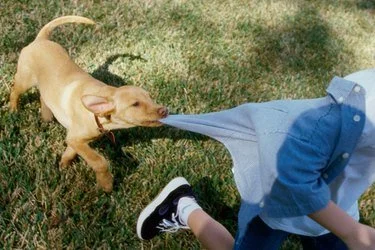Welcome back to the Unleashed Blog! This week, we’re celebrating National Dog Bite Prevention Week, and I've got some important info to share that'll help keep both you and your furry pals safe and happy. You might be surprised to learn that most dog bites don't happen when meeting a strange dog. Nope, according to the American Veterinary Medical Association, it's usually with dogs we already know, especially when it comes to kids.
This really highlights the need for us to teach our little ones about dog safety early on. It's not about scary stray dogs attacking out of nowhere. It's often because kids miss the signs that a dog needs space or feels uncomfortable. Understanding how dogs communicate through body language is key, especially for our youngsters who might not pick up on those signals right away. A lot of times, kids who get nipped by their own family dog just haven't been shown how to interact safely - or maybe they're just too young to get it. That's where us grown-ups come in—we've gotta keep a close eye on things when kids and dogs are together, especially if the dog seems anxious, sick, or in pain. By spreading awareness and keeping a watchful eye, we can really make a difference in preventing dog bites and making sure everyone—humans and pups alike—can enjoy each other's company without any worries.
Common Causes of Bites
Now, let's talk about the other scenarios where dog bites commonly occur. It's not just about interactions with familiar dogs or kids missing cues; there are various reasons why a dog might bite. For instance, a dog that didn't receive proper socialization as a puppy might struggle with understanding boundaries as an adult. Similarly, puppies encouraged to play by nipping at hands instead of being redirected to appropriate toys could develop biting behavior as they grow older. Health issues can also play a significant role. Dogs that are sick or injured might resort to biting as a way to communicate that they're in pain and want humans to stop handling them. Remember the saying, "let a sleeping dog lie"? It holds true because startling a dog awake can lead to fear-driven reactions. Moreover, dogs with a history of maltreatment and abuse may have learned that using their teeth is the only way to protect themselves. It's heartbreaking but true. Of course, there are always exceptions, but the majority of dog bites stem from these common causes. Just like humans, dogs have their limits too. When pushed beyond their threshold of stress and fear, they may resort to biting as a way to protect themselves.
Understanding these various factors helps us approach dog bite prevention from a comprehensive standpoint. It's not just about educating kids and supervising interactions but also about addressing underlying issues that might lead to biting behavior in dogs. By doing so, we can create safer environments for both humans and our beloved canine companions.
Understanding Dog Body Language
Understanding our dogs' body language is key to preventing misunderstandings that could lead to bites. It's like having a conversation without words; we need to pay attention to what they're saying with their actions. Think about it: when your pup starts tensing up, tucking their tail, or avoiding eye contact, it's like they're telling you, "Hey, I'm not feeling too great about this." And as their best friend, it's up to us to listen and respond - we are their biggest advocates.
Sometimes, their signals can be really subtle, like turning their head away or giving you those big puppy eyes. It's their way of saying, "I need a little space, please." Even if what's bothering them seems minor to us—like loud noises or too many people—it can still stress them out. And let's not forget, even the friendliest dog can feel scared and cornered in certain situations. That's why it's crucial to always respect their boundaries and give them an out if they need it. So, next time you notice your pup showing signs of stress, don't ignore them. Take a moment to figure out what's bothering them and help them feel more comfortable. By tuning in to their signals and preventing things from escalating, we can create a happier, safer environment for everyone involved. After all, our pups rely on us to be their voice and keep them out of harm's way.
Additional Scenarios That Increase Stress and Risk
In addition to the situations discussed above, there are a few other scenarios that can really amp up stress levels and pose a higher risk of bites. One such scenario is when a dog has a valuable resource, like food or a toy. For some pups, these things are like treasure, and they'll do whatever it takes to protect them. While many dogs don’t display this behavior, known as resource guarding, for those who do, it's essential for us to understand why and how to manage it safely. There are plenty of training methods out there that can help your resource-guarding pup learn to share, but the best approach is to be proactive from the get-go. That means keeping a close eye on your dog and managing their environment carefully. Don't give your kids the chance to accidentally wander into a situation where they might try to take something valuable from your pup and end up getting hurt. For example, it's a good idea to feed resource-guarding dogs separately from other pets and family members. And when it comes to toys, make sure they're carefully managed and not left lying around where they might become a point of contention. By taking these simple precautions and being mindful of your dog's needs, you can help minimize the risk of any unfortunate incidents and create a safer, happier environment for everyone in your household. After all, keeping our furry friends and our families safe is what it's all about.
Another situation to consider is barrier reactivity, which is similar to resource guarding but involves how a dog reacts when there's a physical barrier between them and others. You might notice that some dogs are perfectly happy to interact with people or other dogs when there's no barrier, but as soon as one is introduced, their behavior can change drastically. For example, think of a dog behind a fence. They might seem calm and friendly, but reaching over that fence to pet them can be risky for both kids and adults alike. It's a situation where misinterpretation of the dog's behavior or unexpected reactions can lead to unfortunate outcomes. It's crucial for everyone to understand that dogs should only be approached with permission, both from their owner and from the dog themselves. Unfortunately, some dog bites occur when the owner isn't around, and a stranger approaches the dog without realizing the potential danger.
Even when the owner is present, there are instances where they might unknowingly put their dog in a stressful situation. For example, insisting that their dog "say hi" to someone when the dog is showing signs of stress or discomfort. These are missed opportunities for clear verbal communication, like saying, "Sorry, my dog isn't feeling up for greetings right now. Maybe another time." Remember you are your dog's biggest advocate so speak up in these situations, even if you feel it may make for an awkward encounter with the person. When dog owners fail to communicate verbally, they miss out on opportunities to protect themselves, their dogs, and others. And on the flip side, if people don't learn to understand the language their dog speaks—body language and verbal cues—misunderstandings are almost inevitable. By being mindful of these nuances and practicing clear communication, both verbal and non-verbal, we can create safer interactions for everyone involved. After all, fostering understanding between humans and dogs is key to building strong relationships that last a lifetime.
Ultimately, the goal is to see a decrease in dog bite incidents as education on the issue becomes more widespread. Dog bites can cause serious harm to people, and the majority of them are entirely preventable! It's heartbreaking to think about the consequences for dogs who have bitten a human. In some cases, it can even lead to euthanasia. What's even sadder is that it's often humans who have failed the dog in those situations. As dog owners, we invite our pups into our homes and our hearts, but we also need to bring them into our conversations and classrooms. A little bit of education can go a long way in preventing harm on both sides—human and canine. By learning to understand and respect our furry companions, we can create safer environments for everyone involved. So, let's continue spreading awareness, practicing good communication, and fostering understanding between humans and dogs. Together, we can make a positive impact and ensure that both humans and their beloved canine companions can live happier, safer lives.
For more information on dog behavior, check out our past posts on How Dogs Communicate Stress and Decoding Canine Communication.








At Off Leash MKE, our team’s love for animals goes beyond the workday — it’s a big part of who we are. In this edition of our Tails of the Team series, we’re excited to introduce you to Lindsey’s pets: Laika, Archer, and Marci! From Laika, the energetic Husky with a larger-than-life personality, to Archer and Marci, her two sweet cats, each has brought unique lessons, joy, and inspiration into Lindsey’s life. Their presence has shaped not only her days at home but also the care and compassion she brings to our clients and their pets every day. Continue reading to learn more.